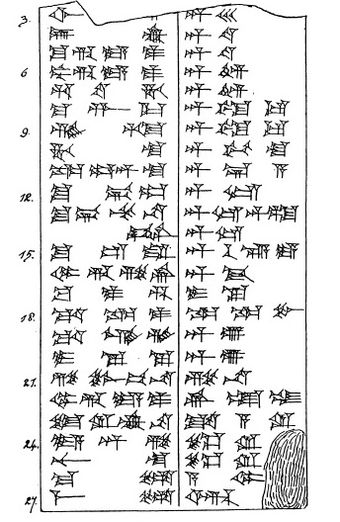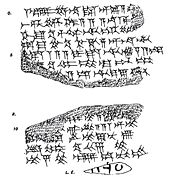

The first two gods in column 2, God Sin, and God Shamash; (Shamash again as God #3).
Gods #4/5 (identical), are the "Wind Gods", Adad, and Rammânu.
The cuneiform an sign (or sumerogram AN, in Akkadian consisting of ASH 𒀸 and MAŠ 𒈦), is a common, multi-use sign, a syllabic for an, and an alphabetic sign used for a, or n; it is common in both the Epic of Gilgamesh over hundreds of years, and the 1350 BC Amarna letters, and other cuneiform texts. It is also used for the designation of a "god", and is sometimes represented as a superscript: , or capitalized: , for "dingir", English language, "god". The example photo at right shows (2nd list), a list of 14 named gods, all with "an"; the first pair on the list AN-UTU, or UTU, refers to the "sun-god", using Ud (cuneiform), as the sumerogram, namely UTU (sun Sumerogram).
Cuneiform an can also be found in compound form with another cuneiform sign, an example being DAGAL, ![]() . The older version of DAGAL used the 'god symbol' as a star within the sign:
. The older version of DAGAL used the 'god symbol' as a star within the sign: ![]() ; (older version of DAGAL, incorporating "star":
; (older version of DAGAL, incorporating "star": ![]() ).
).
Epic of Gilgamesh usage
In the Epic of Gilgamesh, Tablets I-XII, "an" is used for the following meanings by the following numbers: an-(120) times, ìl-(0) times, -(593), AN-(27), and DINGIR-(76) times.
List of Babylonian gods, etc.
From Budge's revised book on Babylonian Life and History, a list of many of the major gods from Babylonian history (and Sumerian):
|
|
List of gods and associated temples, towns, etc.
|
|
References
- Parpola, 1971. The Standard Babylonian Epic of Gilgamesh, Sign List, pp. 155-165, Sign no. 013, p. 155.
- Budge. Babylonian Life and History, E.A. Wallace Budge (Barnes & Noble edition), c 2005 (c 1883, revised 1925), 245 pages, Chapter: "Babylonian Religious Beliefs", pp. 80-95, list: pp. 94-95.
- Budge. Babylonian Life and History, Budge, E.A. Wallace (Barnes & Noble edition), c 2005 (c 1883, revised 1925), 245 pages. (softcover, ISBN 978-0-7607-6549-4)
- Moran, William L. 1987, 1992. The Amarna Letters. Johns Hopkins University Press, 1987, 1992. 393 pages.(softcover, ISBN 0-8018-6715-0)
- Parpola, 1971. The Standard Babylonian Epic of Gilgamesh, Parpola, Simo, Neo-Assyrian Text Corpus Project, c 1997, Tablet I thru Tablet XII, Index of Names, Sign List, and Glossary-(pp. 119–145), 165 pages.(softcover, ISBN 951-45-7760-4)-(Volume 1)
|
|
|

